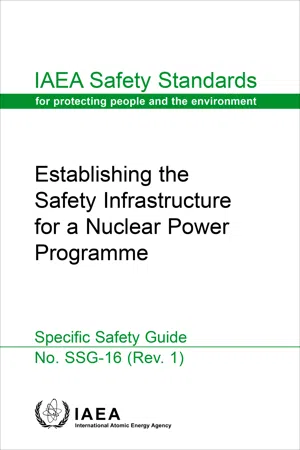1. INTRODUCTION
Background
1.1. IAEA Safety Standards Series No. SF-1, Fundamental Safety Principles [1], provides a coherent set of ten safety principles that constitute the basis for establishing safety requirements to achieve the fundamental safety objective of protecting people and the environment from harmful effects of ionizing radiation. The safety principles form a set that is applicable in its entirety. Although in practice different principles might be more or less important in relation to particular circumstances, the appropriate application of all relevant principles is necessary. When a State is considering embarking on a nuclear power programme, Principle 1 (responsibility for safety), Principle 2 (role of government), Principle 3 (leadership and management for safety), Principle 4 (justification of facilities and activities) and Principle 9 (emergency preparedness and response) are crucial to preparing properly for the future safe operation of a nuclear power plant.
1.2. A considerable period of time is needed to acquire the necessary competences and to foster a strong safety culture before constructing and operating a nuclear power plant. While the prime responsibility for safety rests with the operating organization, the State has the responsibility to create a robust framework for safety upon committing itself to a nuclear power programme, which demands significant investment [1]. Establishing a sustainable safety infrastructure is a long process, and it has been internationally acknowledged that a period of 10–15 years under optimum conditions is generally necessary between the consideration of nuclear power as part of the national energy strategy and the commencement of operation of the first nuclear power plant.
1.3. In 2007, the IAEA published a brochure, Considerations to Launch a Nuclear Power Programme [2], and a guide that was revised in 2015, Milestones in the Development of a National Infrastructure for Nuclear Power [3]. While those publications focus on the entire national infrastructure, the focus of this Safety Guide is on the development of the safety infrastructure for a nuclear power programme.
1.4. A 2008 report by the International Nuclear Safety Group (INSAG) [4] defines nuclear safety infrastructure as “the set of institutional, organizational and technical elements and conditions established in a Member State to provide a sound foundation for ensuring a sustainable high level of nuclear safety.”
1.5. IAEA Safety Standards Series No. GSR Part 1 (Rev. 1), Governmental, Legal and Regulatory Framework for Safety [5], establishes requirements relating to infrastructure for safety. It covers the essential aspects of the governmental and legal framework for establishing a regulatory body and for taking other actions necessary to ensure the effective regulatory control of facilities and activities — existing and new — utilized for peaceful purposes. GSR Part 1 (Rev. 1) [5] applies to all facilities and activities, from the use of a single radiation source to a nuclear power programme. This framework for safety is essentially the part of the ‘nuclear safety infrastructure’ defined in Ref. [4] that is the responsibility of the government.
1.6. Paragraph 2.2 of GSR Part 1 (Rev. 1) [5] states:
“The government establishes national policy for safety by means of different instruments, statutes and laws. Typically, the regulatory body, as designated by the government, is charged with the implementation of policies by means of a regulatory programme and a strategy set forth in its regulations or in national standards. The government determines the specific functions of the regulatory body and the allocation of responsibilities. For example, the government establishes laws and adopts policies pertaining to safety, whereas the regulatory body develops strategies and promulgates regulations in implementation of such laws and policies. In addition, the government establishes laws and adopts policies specifying the responsibilities and functions of different governmental entities in respect of safety and emergency preparedness and response, whereas the regulatory body establishes a system to provide effective coordination.”
1.7. Reference [4] (consistent with Refs [2, 3]) divides the lifetime of a nuclear power plant into five phases from a nuclear safety standpoint. These phases and their indicative average durations are as follows (see Fig. 1):
(a) Phase 1: Safety infrastructure considerations before a decision to launch a nuclear power programm...
